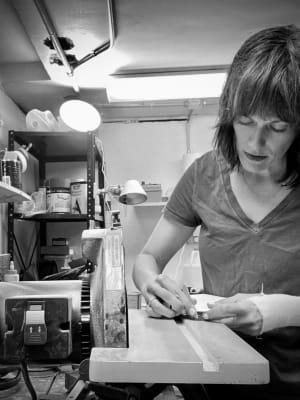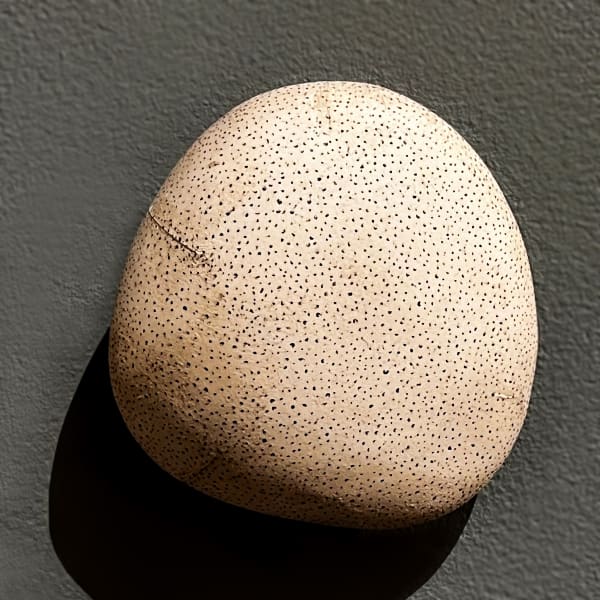Kate Berry Brown was born in 1978 and grew up just outside of Chicago in Evanston, Illinois, where she lives with her husband and three children. As a child of divorced parents, she split her time between her two households: weekdays were spent in Evanston, attending public school and taking extracurricular activities like art, music and dance classes. On the weekends, farther from the city, she explored woods and prairies and learned how to drive a tractor.
Brown attended Washington University Art School, where she earned her BFA in fashion design. After just a few years in the industry, she realized her true passion was not clothes. In fact, it was the act of designing and making that was what she loved, and she found the job of designing clothing to be interchangeable. Not too long after leaving fashion behind she got a job in a flower shop, which scratched her creative itch and allowed her to get her hands dirty. She dove head first into this new passion. Brown’s deep curiosity led her to the Netherlands, where she spent six months getting her Masters in Floral Design at Boerma Instituut. While there, she and her bulldog lived in a trailer she rented from a dairy farmer.
Years later, married, living in Las Vegas and pregnant with their first child, Brown settled back into the fine art of painting. Over the years, through the move back to the Midwest and two more kids, drawing replaced painting out of both practicality as well as a deep love for immediate and meditative mark-making. She found that picking up and putting down a pencil was faster than cleaning a brush and mixing paints while simultaneously wrangling three small children.
Woodworking is Brown’s current endeavor. What intrigues her remains consistent to constructing a dress or making a floral arrangement: design, color, texture and that which drives her more than anything is passion and curiosity.
-
"Three years ago, on a tiny, unassuming island off the coast of Massachusetts called Cuttyhunk, I began my woodworking journey ... There’s no way of coming away unchanged from living such a simple island life; walking under vast skies every day for an entire season, completely surrounded by the ocean, collecting stones and moon shells."
-
-
"The drawings I was mounting on the wood available to me were replaced by plain white paper; the softness of the paper wrapping around the wood curves—the hush of each piece—became my new inspiration."
-
-
"I sand, I cut, I glue, and repeat, making changes as I go. I let the design go where it wants, where it feels right. And most importantly I edit ruthlessly, reducing all excess so that no lines, cuts, or marks are extraneous. Often I find myself surprised by how each piece turns out. Tumbled and sculpted, sort of like a gift from the sea."
-
-
"Lake Michigan is unlike the ocean with its tides and majestic creatures, but it is a grand body of water in its own right ... Walks and drives along the lake growing up taught me about and instilled a need for breathing room. So today I chase space—a moment of clarity or a deep breath—and I want to harness that in my work."
-
-
"I use minimalism as a tool to convey lucidity ... For instance, if I add texture, I subtract cuts in the wood ... I believe (as I look at my own unadorned white walls) that in nothingness there is a possibility of anything."
-
-
"Last year we returned to Cuttyhunk for an even longer stay. We arrived at the start of February to escape Covid ... there is a scrappiness that appeals to me about island life. One makes do with what one has. I used plywood and cast-off cedar shingles, and since my dad himself loves to woodwork, I also scrounged around and found beautiful scraps of walnut and cherry."
-
-
"I envisioned making frames or adding some sort of sculptural element to give dimensionality to my work on paper. I was tired of relying on the framers to finish my work. Working in my dad’s wood shop, he taught me how to use the tools I needed and how to execute any idea that I had."
-
-
"On the beach I love to watch the ocean waves rhythmically bring in and carry away stones and shells. If you can’t catch them fast enough, back out to sea everything goes. Each rock has been through years of churning, breaking, and reforming deep below the surface of the water. I can’t help but feel this journey is a metaphor for life, all this cracking and reshaping."
-
-
"My wood and paper wall sculptures are tokens of that fragility and strength, symbols of impermanent but infinite beauty. I sketch out shapes and loose ideas in my sketchbook, on napkins, on brochures. But I only use my sketch as a guide, because once I cut the wood, the piece takes on a world of its own."
-
-
"My materials are minimal and consist of wood and paper. Often to finish a piece, I use muted hues in ink or acrylic paint ... Nothing else is simple in life (and I am not outwardly a minimalist person) so I love to make pieces that are, with a small wish that life could feel so polished and digestible."
-
-
"The size of the wood determined the size of my finished piece. Parameters like this are fun for me; there is a pureness in the challenge of using only what is available. Returning home, I have held onto what I learned and discovered in Cuttyhunk. Realistically it is impossible to live such a pared down life as we did there. But with each piece I make, I strive to recreate the feeling."
-











